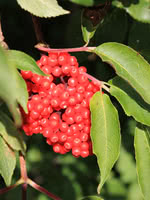Mon-Fri 9am - 5pm Mountain time
Sea Buckthorn (Seaberry) vs Red Elderberry
Hippophae rhamnoides l.
Sambucus racemosa
NOT AVAILABLE THIS SEASON - MIGHT RETURN
Sea Buckthorn, aka Seaberry, is a nitrogen fixing shrub that produces attractive berries high in vitamin C.
While we can't confirm claims that the berries are effective in treating various ailments, many people believe consuming the berries helps with arthritis, infections, and asthma, among other things.
Sea Buckthorn plants have attractive pale silvery-green leaves, dense branches, and large thorns, people like to grow in ornamental hedges or as a first row in a shelterbelt.
Note: these plants typically reach maturity and make their sex easily known (females producing fruit) in their 3rd or 4th year of growth. Our seedlings are too young to identify their sex.
Red Elderberry is an attractive, medium-sized deciduous shrub.
It produces clusters of white flowers in the spring and bright red berry-like drupes, which provide beautiful contrast against its coarse, textured green foliage.
Red Elder can be pruned as a small single or multi-stemmed tree.
Sea Buckthorn (Seaberry) Quick Facts
Red Elderberry Quick Facts
Toxicity: toxic to humans
In row spacing: 0.9 - 1.2 m (3 - 4 ft)

